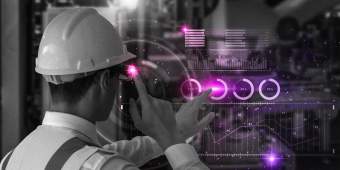2. How spatial computing can make compliance easier
Quality assurance and quality control are essential parts of maintaining compliance. Spatial computing, enhanced by immersive technologies such as extended reality (XR), can make that work more efficient and even more intuitive by offering a more experiential way of doing root cause / failure analysis (RCFA) when something goes wrong.
RCFA, of course, involves gathering complex data about failures and analyzing it to pinpoint a root cause. One of the most compelling early applications for spatial computing is its ability to facilitate data analysis using artificial intelligence (AI) and machine learning algorithms.
Because spatial computing makes it possible to view data in three dimensions, the process of “analysis” becomes more a process of “experience.” QA and QC professionals can create graphs with a x, y, and z axes, rotate them to consider data from various angles, and see relationships that might remain invisible in a two-dimensional chart, thanks to computer vision techniques.
What's more, the “infinite screen” that spatial computing allows means that QA and QC professionals can view as many data sources as they want simultaneously, again facilitating the work of uncovering relationships, trends, and patterns—and, ultimately, finding answers. This capability is particularly useful in virtual environments, where professionals can interact with 3D models of the data.
Getting to those answers faster means manufacturers and logistics companies can scrap less work, do less rework, and slash downtime.
Another, simpler application: instead of having quality control associates painstakingly type out SOP documents, a spatial computing headset could simply record their activities as they carry out the process in question, translate their actions using an AI motion-to-text application, and output an SOP doc for the associate to edit. Scaled across an organization, the time savings would be significant.
As VR headsets became ubiquitous, the SOP doc might die out completely in favor of a 3D recording other associates could follow, creating the next generation for efficiency and compliance adherence.
3. How spatial computing can detect defects better
Automating defect detection has been a challenge for many industries, particularly for complex inspection tasks within industries—such as verifying weld seams on auto frames or checking the integrity of bottle labels.
Spatial computing could provide a transformative solution, leveraging advancements in technology to enhance accuracy and efficiency.
One hypothetical example: A human inspector wearing an augmented reality headset could essentially turbo-charge their ability to detect defects, using the headset as a tool to mitigate distractions, fatigue, and other sources of human error. This is achieved through the integration of real-time feedback and eye-tracking technology, which ensures that inspectors are focusing on potential problem areas in the physical environment. At the same time, an app in the headset can record countless images of acceptable and defective parts—in different lighting conditions, different orientations, from different angles, with different backgrounds, etc.
This data could then be used to train an AI model to make machine-only detection for even greater accuracy. The fundamentals of spatial computing allow for a seamless overlay of virtual objects onto the physical world, enhancing user experience by making the inspection process more intuitive and effective.
After the fact, analysts equipped with extended reality headsets can review defect data in three dimensions, allowing them to more easily identify trends and patterns that lead them to solutions. This capability not only streamlines the process but also enhances the precision of defect detection, making it an indispensable tool in modern manufacturing environments.
The future is bright for manufacturing and logistics with spatial computing
As exciting as the applications we discuss in this article are, they merely scratch the surface of what's possible with spatial computing. Just as the iPhone revolutionized mobile communications after its launch in 2007 and Uber transformed personal transport two years later, we are just beginning to explore the future of spatial computing in the industrial sector.
We are in the nascent stages of understanding the full spectrum of possibilities that spatial computing can offer. As forward-thinking organizations experiment with AR apps and digital content, and as they learn from case studies that showcase successful implementations, the divide between industry leaders and and followers will undoubtedly widen. These leaders optimize their processes and workflows through advanced spatial computing technologies, setting new benchmarks in efficiency and innovation.
The best way to prepare your organization to be among the former? Make sure your data is in order. The potential applications of spatial computing are significant, but they all require underlying data maturity.
Not sure where your data stands? Check out ourData Maturity Accelerator, a one-week engagement that delivers you a roadmap to getting your data where it needs to be to fully harness the capabilities of Industry 4.0. This strategic initiative will not only optimize your current data but also prepare you to capitalize on the groundbreaking advancements in spatial computing, paving the way for a future where digital and physical realities converge seamlessly.




